Falconidae
The falcons and caracaras are around 65 species of diurnal birds of prey that make up the family Falconidae (representing all extant species in the order Falconiformes). The family is divided into three subfamilies: Herpetotherinae, which includes the laughing falcon and forest falcons; Polyborinae, which includes the spot-winged falconet and the caracaras; and Falconinae, the falcons and kestrels (Falco) and falconets (Microhierax).
| Falcons and caracaras | |
|---|---|
 | |
| Brown falcon (Falco berigora) | |
| Scientific classification | |
| Domain: | Eukaryota |
| Kingdom: | Animalia |
| Phylum: | Chordata |
| Clade: | Dinosauria |
| Class: | Aves |
| Order: | Falconiformes |
| Family: | Falconidae Leach, 1820 |
| Subfamilies | |
Description
Falcons and caracaras are small to medium-sized birds of prey, ranging in size from the black-thighed falconet, which can weigh as little as 35 grams (1.2 oz), to the gyrfalcon, which can weigh as much as 1,735 grams (61.2 oz). They have strongly hooked bills, sharply curved talons and excellent eyesight. The plumage is usually composed of browns, whites, chestnut, black and grey, often with barring of patterning. There is little difference in the plumage of males and females, although a few species have some sexual dimorphism in boldness of plumage.
Distribution and habitat
The family has a cosmopolitan distribution across the world, absent only from the densest forest of central Africa, some remote oceanic islands, the high Arctic and Antarctica. Some species have exceptionally wide ranges, particularly the cosmopolitan peregrine falcon, which ranges from Greenland to Fiji and has the widest natural breeding distribution of any bird. Other species have more restricted distributions, particularly island endemics like the Mauritius kestrel. Most habitat types are occupied, from tundra to rainforest and deserts, although they are generally more birds of open country and even forest species tend to prefer broken forest and forest edges. Some species, mostly in the genus Falco, are fully migratory, with some species summering in Eurasia and wintering entirely in Africa, other species may be partly migratory. The Amur falcon has one of the longest migrations, moving from East Asia to southern Africa.[1]
Behaviour
Diet and feeding
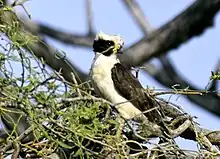
Falcons and caracaras are carnivores, feeding on birds, small mammals including bats,[2] reptiles, insects and carrion. In popular imagination the falconids are fast flying predators, and while this is true of the genus Falco and some falconets, other species, particularly the caracaras, are more sedentary in their feeding. The forest falcons of the Neotropics are generalist forest hunters. Several species, particularly the true falcons, will stash food supplies in caches.[3] They are solitary hunters and pairs guard territories, although they may form large flocks during migration. Some species are specialists, such as the laughing falcon, which specialises in snakes; others are more generalist in their diet.
Breeding
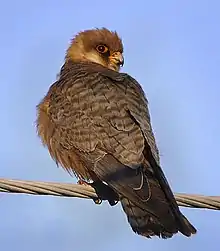
The falcons and caracaras are generally solitary breeders, although around 10% of species are colonial, for example the red-footed falcon.[4] They are monogamous, although some caracaras may also employ alloparenting strategies, where younger birds help adults (usually their parents) in raising the next brood of chicks. Nests are generally not built (except by the caracaras), but are co opted from other birds, for example pygmy falcons nest in the nests of weavers, or on the ledges on cliffs. Around 2–4 eggs are laid, and mostly incubated by the female. Incubation times vary from species to species and are correlated with body size, lasting 28 days in smaller species and up to 35 days in larger species. Chicks fledge after 28–49 days, again varying with size.
Relations with humans
Falcons and caracaras have a complicated relationship with humans. In ancient Egypt they were deified in the form of Horus, the sky and sun god who was the ancestor of the pharaohs. Caracaras also formed part of the legends of the Aztecs. Falcons were important in the (formerly often royal) sport of falconry. They have also been persecuted for their predation on game and farm animals, and that persecution has led to the extinction of at least one species, the Guadalupe caracara. Several insular species have declined dramatically, none more so than the Mauritius kestrel, which at one time numbered no more than four birds. Around five species of falcon are considered vulnerable to extinction by the IUCN, including the saker falcon.
Taxonomy and systematics
The family Falconidae was introduced by the English zoologist William Elford Leach in a guide to the contents of the British Museum published in 1820.[5][6] The family is composed of three main branches: the falconets and true falcons, the caracaras, and the forest falcons. Differences exist between authorities in how these are grouped into subfamilies. Also, the placement of the laughing falcon (Herpetotheres) and the spot-winged falconet (Spiziapteryx) varies. One common approach uses two subfamilies Polyborinae and Falconinae. The first contains the caracaras, forest falcons, and laughing falcon. All species in this group are native to the Americas.[7]
The composition of Falconidae is disputed, and Polyborninae is not featured in the American Ornithologists' Union checklists for North and South American birds that are produced by its Classification Committees (NACC and SACC). The Check-list of North American Birds considers the laughing falcon a true falcon (Falconinae) and replaces Polyborinae with Caracarinae and Micrasturinae.[8] On the other hand, the Check-list of South American Birds classifies all caracaras as true falcons and puts the laughing falcon and forest falcons into the subfamily Herpetotherinae.[9]
Falconinae, in its traditional classification, contains the falcons, falconets, and pygmy falcons.[10] Depending on the authority, Falconinae may also include the caracaras and/or the laughing falcon.[9][11]
Phylogeny
The following cladogram is based on a comprehensive molecular phylogenetic study of the Falconidae by Jérôme Fuchs and collaborators that was published in 2015. The number of species is taken from the list of birds maintained by Frank Gill, Pamela Rasmussen and David Donsker on behalf of the International Ornithological Committee (IOC).[12][13] Fuchs and collaborators recommended that the genus Daptrius should be expanded to include the genera Phalcoboenus and Milvago due to the shallow genetic divergence. This change has been adopted by the Clements Checklist but not by the IOC.[13][12][14]
| Falconidae |
| ||||||||||||||||||||||||||||||||||||||||||||||||||||||||||||||||||
List of genera
Below is list of the subfamilies and genera of the Falconidae.[13]
| Subfamily | Image | Genus | Species |
|---|---|---|---|
| Herpetotherinae | 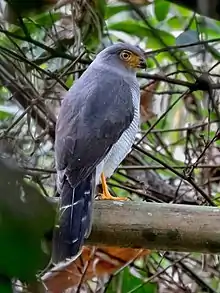 |
Micrastur G.R. Gray, 1841 – forest falcons |
|
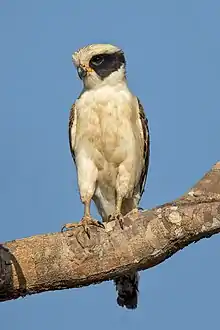 |
Herpetotheres Vieillot, 1817 – laughing falcon |
| |
| Polyborinae | 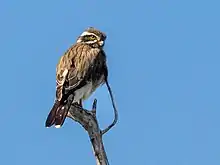 |
Spiziapteryx Kaup, 1852 |
|
 |
Caracara Merrem, 1826 – crested caracara |
| |
 |
Ibycter Vieillot, 1816 |
| |
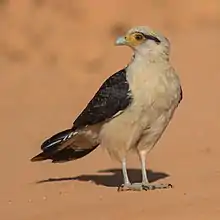 |
Milvago Spix, 1824 – brown caracaras |
| |
_(14909975447)_(cropped).jpg.webp) |
Daptrius Vieillot, 1816 |
| |
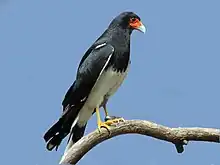 |
Phalcoboenus d'Orbigny, 1834 |
| |
| Falconinae | 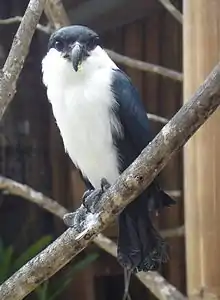 |
Microhierax Sharpe, 1874 – typical falconets |
|
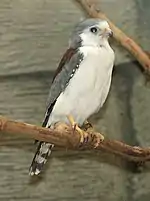 |
Polihierax Kaup, 1847 |
| |
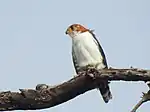 |
Neohierax Swann, 1922 |
| |
 |
Falco Linnaeus, 1758 – true falcons, hobbies and kestrels |
| |
Fossil genera
- Badiostes (Santa Cruz Early Miocene of Patagonia, Argentina)
- Falconidae gen. et sp. indet. (Early Miocene of Chubut, Argentina)
- Falconidae gen. et sp. indet. (Pinturas Early/Middle Miocene of Argentina)
- Pediohierax (Middle Miocene of Nebraska, US) – formerly Falco ramenta
- Falconidae gen. et sp. indet. (Cerro Bandera Late Miocene of Neuquén, Argentina)[15]
- "Sushkinia" pliocaena (Early Pliocene of Pavlodar, Kazakhstan) – belongs in Falco?
- Thegornis (Miocene of South America)
References
- Tordoff, Andrew (2002). "Raptor migration at Hoang Lien Nature Reserve, northern Vietnam" (PDF). Forktail. 18: 45–48. Archived from the original (PDF) on 2011-06-10.
- Mikula, P., Morelli, F., Lučan, R. K., Jones, D. N., & Tryjanowski, P. (2016). Bats as prey of diurnal birds: a global perspective. Mammal Review.
- Collopy, M.W. (1977). "Food Caching by Female American Kestrels in Winter". Condor. 79 (1): 63–68. doi:10.2307/1367531. JSTOR 1367531.
- Ille, R.; Hoi, H.; Grinschgl, F.; Zink, F. (2002). "Paternity assurance in two species of colonially breeding falcon: the kestrel Falco tinnunculus and the red-footed falcon Falco vespertinus". Etologica. 10: 11–15.
- Leach, William Elford (1820). "Eleventh Room". Synopsis of the Contents of the British Museum. Vol. 17 (17th ed.). London: British Museum. p. 65. Although the name of the author is not specified in the document, Leach was the Keeper of Zoology at the time.
- Bock, Walter J. (1994). History and Nomenclature of Avian Family-Group Names. Bulletin of the American Museum of Natural History. Vol. Number 222. New York: American Museum of Natural History. p. 133. hdl:2246/830.
- Myers, P. R.; C. S. Parr; T. Jones; G. S. Hammond; T. A. Dewey. "Subfamily Polyborinae (caracaras and forest falcons)". Animal Diversity Web. University of Michigan. Retrieved 2009-08-15.
- "Check-list of North American Birds". North American Classification Committee. American Ornithologists' Union. Archived from the original on 2011-06-06. Retrieved 2009-08-15.
- "A classification of the bird species of South America". South American Classification Committee. American Ornithologists' Union. Archived from the original on August 1, 2009. Retrieved 2009-08-15.
- Myers, P. R.; C. S. Parr; T. Jones; G. S. Hammond; T. A. Dewey. "Subfamily Falconinae (falcons)". Animal Diversity Web. University of Michigan. Retrieved 2009-08-17.
- "Check-list of North American Birds". North American Classification Committee. American Ornithologists' Union. Archived from the original on 2011-06-06. Retrieved 2009-08-17.
- Fuchs, J.; Johnson, J.A.; Mindell, D.P. (2015). "Rapid diversification of falcons (Aves: Falconidae) due to expansion of open habitats in the Late Miocene". Molecular Phylogenetics and Evolution. 82: 166–182. doi:10.1016/j.ympev.2014.08.010. PMID 25256056.
- Gill, Frank; Donsker, David; Rasmussen, Pamela, eds. (January 2023). "Seriemas, falcons". IOC World Bird List Version 13.1. International Ornithologists' Union. Retrieved 4 February 2023.
- Clements, J.F.; Schulenberg, T.S.; Iliff, M.J.; Fredericks, T.A.; Gerbracht, J.A.; Lepage, D.; Billerman, S.M.; Sullivan, B.L.; Wood, C.L. (2022). "The eBird/Clements Checklist of Birds of the World: v2022". Retrieved 4 February 2023.
- PVPH 465: a phalanx 1 of the middle toe. A caracara? Possibly belongs in extant genus. Kramarz, Alejandro: Garrido, Alberto; Forasiepi, Analía; Bond, Mariano & Tambussi, Claudia (2005): Estratigrafía y vertebrados (Aves y Mammalia) de la Formación Cerro Bandera, Mioceno Temprano de la Provincia del Neuquén, Argentina. Revista Geológica de Chile 32(2): 273–291. HTML fulltext
External links
- Falconidae videos, photos and sounds on the Internet Bird Collection